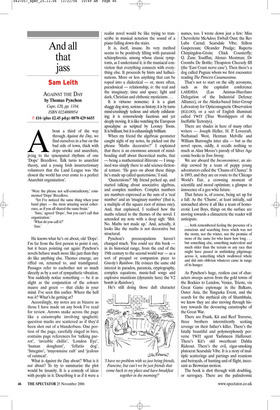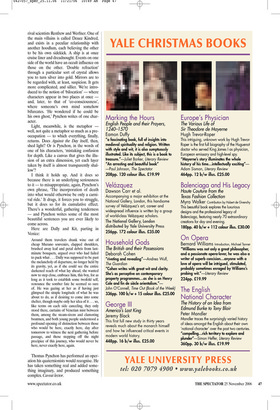And all that jass
Sam Leith
AGAINST THE DAY by Thomas Pynchon Cape, £20, pp. 1104, ISBN 0224080954 ✆ £16 (plus £2.45 p&p) 0870 429 6655 About a third of the way through Against the Day, we find ourselves in a bar on the bad side of town, thick with dope smoke and anarchists, jiving to the syncopated rhythms of one ‘Dope’ Breedlove. Talk turns to anarchist theory, and a young Irish insurrectionary volunteers that the Land League was ‘the closest the world has ever come to a perfect Anarchist organization’.
‘Were the phrase not self-contradictory,’ commented ‘Dope’ Breedlove.
‘Yet I’ve noticed the same thing when your band plays — the most amazing social coherence, as if you all shared the same brain.’ ‘Sure,’ agreed ‘Dope’, ‘but you can’t call that organization.’ ‘What do you call it?’ ‘Jass.’
He knows what he’s on about, old ‘Dope’. I’m far from the first person to point it out, but it bears pointing out again: Pynchon’s novels behave much more like jazz than they do like anything else. Themes emerge, are riffed on, returned to, and transfigured.
Passages refer to eachother not so much directly as by a sort of sympathetic vibration.
You suddenly notice something — be it as slight as the conjunction of the colours mauve and green — that clicks in your mind. I’ve seen this earlier. Where the hell was it? What’s he getting at?
Accordingly, my notes are as bizarre as those I have made on any book I’ve read for review. Arrows snake across the page like a catastrophe involving spaghetti; question marks are scattered as if they’d been shot out of a blunderbuss. One por tion of the page, carefully ringed in biro, contains page references for ‘talking parrot’, ‘invisible chillis’, ‘London Eye’, ‘human doughnut’, ‘fellatio dog’, ‘Smegmo’, ‘mayonnaise cult’ and ‘jealous of oatmeal’.
What is Against the Day about? What is it not about? To try to summarise the plot would be insanity. It is a comedy of ideas with people in it. Describing it as if it were a realist novel would be like trying to transcribe in musical notation the sound of a piano falling down the stairs.
It is, itself, insane. Its very method seems to be positively lifting with paranoid schizophrenia, among whose classic symptoms, as I understand it, is the maniacal conviction that everything connects with everything else. It proceeds by hints and hallucinations. More or less anything that can be roped into a dialectical — or, more often, paradoxical — relationship, is: the real and the imaginary; time and space; light and dark; Christian and chthonic mysticisms . . .
It is virtuoso nonsense; it is a giant shaggy dog story, serious as history; it is by turns mind-crushingly tedious and utterly exhilarating; it is remorselessly facetious and yet deeply moving. It is like watching the European apocalypse as scripted by Looney Toons. It is brilliant, but it is exhaustingly brilliant.
When my friend the algebraic geometer caught sight of my notes, he picked out the phrase ‘Maths decorative?’ I explained that there is an enormous amount of mindbending stuff about theoretical maths, that — being a mathematical illiterate — I imagined was simply there to add science-fictional texture. ‘He goes on about these things he’s made up called quaternions,’ I said.
‘Quaternions?’ My friend perked up, and started talking about associative algebras, and complex numbers. Complex numbers are numbers expressed as the sum of a ‘real number’ and an ‘imaginary number’ (that is, a multiple of the square root of minus one). And, that explained, I realised how the maths related to the themes of the novel. I amended my note with a deep sigh: ‘Shit. No. Maths not made up.’ And, actually, it looks like the maths is not decorative but structural.
Pynchon’s preoccupations haven’t changed much. You could see this book in its historical range, from the end of the 19th century to the second world war — as a sort of prequel or companion piece to Gravity’s Rainbow. He evinces the same old interest in paradox, paranoia, cryptography, complex equations, music-hall songs and explosive munitions (dynamite here; the V2 bomb in Rainbow).
He’s still doing those daft character names, too. I wrote down just a few: Miss Chevrolette McAdoo; Ewball Oust; the Rev Lube Carnal; Scarsdale Vibe; Stilton Gaspereaux; Oleander Prudge; Ruperta Chirpingdon-Groin; Chick Counterfly; Q. Zane Toadflax; Alonzo Meatman; Dr Coombs De Bottle; Thrapston Cheesely III (the ‘East Coast nerve case’). Then there’s a dog called Pugnax whom we first encounter reading The Princess Casamassima.
That’s not to start on the silly acronyms, such as the capitalist conference LAHDIDA (Las Animas-Huerfano Delegation of the Industrial Defence Alliance), or the Alaska-based Inter-Group Laboratory for Opticomagnetic Observation (IGLOO), or a sect of English illuminati called TWIT (True Worshippers of the Ineffable Tectratys).
There are shades in here of many other writers — Joseph Heller, H. P. Lovecraft, Nathanael West, Herman Melville and William Burroughs inter alia — but as the novel opens, oddly, it recalls nothing so much as Alan Moore’s parody of Silver Age comic books in Tom Strong.
We are aboard the Inconvenience, an airship crewed by a team of peppy young adventurers called the ‘Chums of Chance’. It is 1893, and they are en route to the Chicago World’s Fair, a crowning moment of scientific and moral optimism; a glimpse in innocence of a gee-whiz future.
That future is, of course, being set up for a fall. As the ‘Chums’, at least initially, sail untouched above it all like a team of homoerotic Lost Boys, things on the surface are moving towards a climacteric the reader will anticipate.
. . . both remembered feeling the presence of a conscious and searching force which was not the storm, nor the winter, nor the promise of more of the same for who knew how long . . . but something else, something malevolent and much older than the terrain or any race that might have passed in unthinking pilgrimage across it, something which swallowed whole and shit into oblivion whatever came in range of its hunger.
As Pynchon’s huge, restless cast of characters sweeps across from the gold towns of the Rockies to London, Venice, Trieste, via Great Game espionage in the Balkans, Outer Asia, the Tungaska Event, and the search for the mythical city of Shambhala, we know they are also moving through history towards the devouring catastrophe of the Great War.
There are Frank, Kit and Reef Traverse, three brothers intermittently seeking revenge on their father’s killer. There’s the fatally beautiful and polymorphously perverse TWIT agent Yashmeen Halfcourt. There’s Kit’s old sweetheart Dahlia Rideout. There’s the evil, cigar-smoking plutocrat Scarsdale Vibe. It is a story of multiple scatterings and partings and reunions and betrayals, of hunting and of flight, incessant as Brownian motion.
The book is shot through with doubling, or surrogacy. There are the palindromic rival scientists Renfrew and Werfner. One of the main villains is called Deuce Kindred, and exists in a peculiar relationship with another hoodlum, each believing the other to be his own sidekick. A ship is at once cruise liner and dreadnought. Events on one side of the world have an occult influence on those on the other. ‘Double refraction’ through a particular sort of crystal allows you to turn silver into gold. Mirrors are to be regarded with, at least, suspicion. It gets more complicated, and sillier. We’re introduced to the notion of ‘bilocation’ — where characters appear in two places at once and, later, to that of ‘co-consciousness’, where someone’s own mind somehow bifurcates. ‘He wondered if he could be his own ghost,’ Pynchon writes of one character.
Light, meanwhile, is the metaphor well, not quite a metaphor so much as a preoccupation — to which everything, finally, returns. Does Against the Day itself, then, shed light? Or is Pynchon, in the words of one of his characters, ‘mistaking confusion for depth. Like a canvas that gives the illusion of an extra dimension, yet each layer taken by itself is almost transparently shallow’?
I think it holds up. And it does so because there is an underlying seriousness to it — to misappropriate, again, Pynchon’s own phrase, ‘The incorporation of death into what would otherwise be only a carnival ride.’ It drags, it forces you to struggle, but it does so for its cumulative effect. There’s a wonderful, gathering tenderness — and Pynchon writes some of the most beautiful sentences you are ever likely to come across.
Here are Dally and Kit, parting in Venice:
Around them travelers drank wine out of cheap Murano souvenirs, clapped shoulders, brushed away leaf and petal debris from lastminute bouquets, argued over who had failed to pack what . . . Dally was supposed to be past the melancholy of departure, no longer held by its gravity, yet, as if she could see the entire darkened reach of what lay ahead, she wanted now to step close, embrace him, this boy, for as long as it took to establish some twofold self, renounce the somber fate he seemed so sure of. He was gazing at her as if having just glimpsed the simple longitude of what he was about to do, as if desiring to come into some shelter, though maybe only her idea of it . . . so, like terms on each side canceling, they only stood there, curtains of Venetian mist between them, among the steam-sirens and clamoring boatmen, and both young people understood a profound opening of distinction between those who would be here, exactly here, day after tomorrow to witness the next gathering before passage, and those stepping off the night precipice of this journey, who would never be here, never exactly here, again.
Thomas Pynchon has performed an operation his quaternionists would recognise. He has taken something real and added something imaginary, and produced something complex. Caveat lector.



























































































 Previous page
Previous page